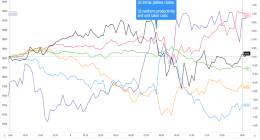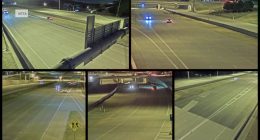
THE CHESAPEAKE & OHIO Canal National Historical Park stretches along the Potomac River for 184.5 miles, from Washington, D.C., to Cumberland, Md. Dr. Anthony Fauci, President Biden’s chief medical adviser, power walks in the park. I prefer to wander. Over the last year my friend Lauri Menditto and I—we both live in D. C.—section-hiked the towpath that runs the entire length of the park. Because there are mile markers and a singular thoroughfare, you’d be hard-pressed to get lost, and, since I’m a notoriously terrible pathfinder, more than one person has suggested to me that’s why I’m so fond of it; you just keep walking. But the main draw of the towpath is that you can get lost, at least mentally. Between the splendor of its woods and river, and the 19th relics that populate it, the towpath is meditative and exciting all at once, as if someone had untangled a labyrinth. What was transportation remains transporting.
Built alongside the Potomac to surmount the river’s natural obstacles, like rapids, the Chesapeake & Ohio Canal operated from 1831 to 1924, moving freight between western Maryland and Washington, D.C. Mules walked a towpath beside the canal to pull the laden boats. Railroads and highways made this mode of shipping obsolete but the canal itself, now largely dry, and its towpath remained. Supreme Court Justice William O. Douglas, who enjoyed hiking the towpath, was among its most vocal boosters. “That’s what the cities need,” he wrote, “a wilderness at their back door, where a man can go and once more find harmony and peace in his inner being.” In January 1954, two newspaper editors advocated building a road along the Potomac, either along or in place of the government-owned canal. Douglas invited the journalists—plus dozens of others—to walk the towpath with him. They set out from Cumberland that March. Walkers, who became known as the “blister brigade,” reveled in the river’s natural charms and gamely kept pace with the justice. Nine people, including Douglas, walked the entire way. In 1971, the canal became a key part of a national park, dedicated to Douglas in 1977.
Now, many people ride bikes along the canal’s towpath. You can also kayak on the waterways around the canal. But for me, walking is the ideal pace to take in its quiet marvels: pawpaws, hawks and mergansers, abandoned locks, and waterfalls and caves. Afoot, you experience the juxtaposition of what the C&O canal was—a vital waterway, teeming with humans and animals—with what’s here now, including old landmarks patiently tolerating vegetative growth. The canal itself only has water in some spots; otherwise it’s grassy in some areas and forested in others. “It’s a wonderful confluence of things,” said Bill Holdsworth, the president of the C&O Canal Association, which originated as an outgrowth of Douglas’ hike. My father-in-law, who also loves the canal, gave me a membership in the association. It comes with a nametag for group events.
During the Covid crisis, when green spaces were deemed the safest alternative to staying home, visits to the canal spiked, said Robin Zanotti, the president of the C&O Canal Trust, the park’s philanthropic partner. “People who didn’t usually use the park are falling in love with it,” she said. Here, four particularly scenic stretches alongside the Chesapeake & Ohio Canal, ranging from a 60- to 90-minute drive from Washington, D.C.
For history fans: Harpers Ferry, W.Va.
Suggested stroll: Harpers Ferry to Mile Marker 62 (2.5 miles one-way). Park near the train station in Harpers Ferry, where the Potomac and Shenandoah Rivers come together and where abolitionist John Brown led the raid on the federal armory in 1859. Signs will lead you across the pedestrian bridge over the Potomac at the base of town. Stairs down from the bridge deposit you onto the towpath and into Maryland, at Lock 33, mile 60.7. From there, go west. A little after Mile Marker 61, a gravelly area next to the water invites a rest. Benches at Lock 34, just after that, offer more spots to contemplate the Potomac as it flows over boulders.




